This was published 5 months ago
‘I was drunk on power’: How this artist channelled his Pentecostal youth for a powerful new work
Choreographer Joel Bray revisits his Pentecostal upbringing in a new show that took him by surprise.
By John Bailey
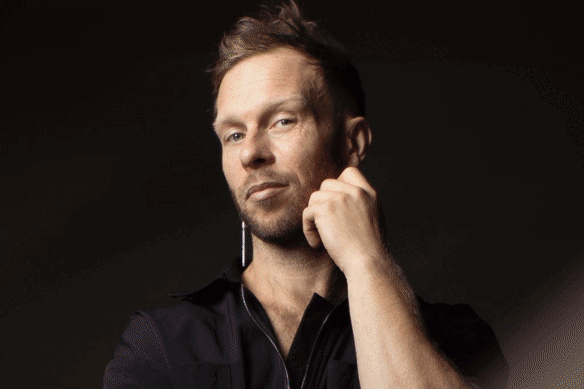
When Joel Bray reached adulthood he gave God an ultimatum. For 18 years he’d been a dutiful member of the Pentecostal church, but whenever his fellow faithful spoke in tongues or fainted in ecstasy, he’d have to pretend. He’d never felt the presence of the Holy Spirit, and he endured the sermons that spoke of his queerness as a sin. Finally he decided his relationship with the Lord was a little too one-sided.
He walked into an empty church one mid-week morning. “OK, God,” he said aloud. “I know I’m queer. You know I’m queer. But I think I’m done with the church and I think I’m done with you. It’s been 18 years, so I just wanted to give you one last right of reply.”
He waited for a clap of thunder or some white doves to descend. Nothing.
“But I remember this very clear sense of relief,” he says now. “A softening. In a way it was my first spiritual experience, ironically. I never looked back. I never went to church again, never talked to God again, and I became one of the gayest people I know. Built a whole art practice around it.”
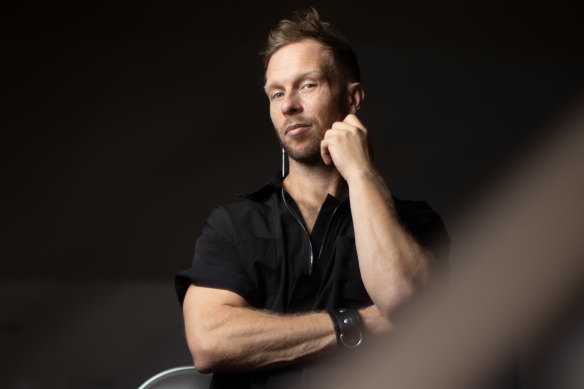
Joel Bray: “I wanted to become one of those really famous, really rich evangelists.”Credit: Simon Schluter
Today, Bray is one of Australia’s most lauded choreographers, with a swag of awards under his belt and a distinct authorial voice. His works are spaces in which his Wiradjuri kin and nightclub peers can dance shoulder to shoulder, contemporary dance floors drawing together history, family and the complexities of identity.
Until now, though, he’s never included his religious upbringing in that mix. Homo Pentecostus fuses dance and text as Bray reckons with the legacy of the church in ways that have surprised even him. “It could very easily have been that this inner-city, atheist, queer man makes a show about how ridiculous the Pentecostals are in their fundamentalist faith, and how homophobic they are. It could have been a show that the audience could anticipate.”
But during development he teamed up with actor Peter Paltos, who by coincidence had been a Pentecostal in his late teens and early 20s. Paltos has since left the church but, unlike Bray, he doesn’t consider himself a non-believer. “I’ve maintained a spiritual practice. A non-denominational Christian-ish New Agey practice outside the church.”
As soon as Paltos began working with Bray, the whole dynamic of Homo Pentecostus began to shift. “Having this person going ‘actually I do believe in something’ has meant that the work has become less about dragging the Pentecostal church through the mud and much more exploring what it means to be a queer person in 2024 and engaging with spirituality,” Bray says.
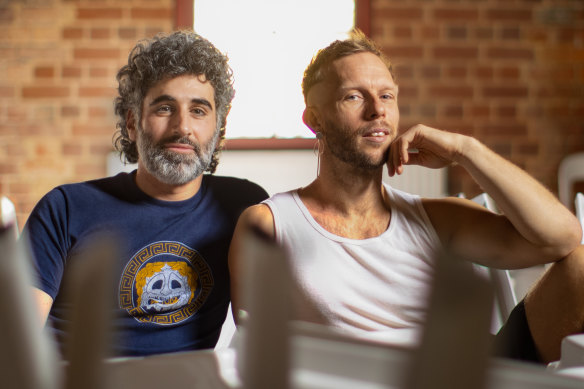
Joel Bray, right, with Peter Paltos, who brought a shift in focus to the work.Credit: Simon Schluter
Those outside the Pentecostal church might vaguely know it as the happy-clappy, song-and-dance wing of Christianity. “They believe in the Bible and Jesus and everything, but they’re glossy. They’ve updated the image and the branding. Instead of the music being an organ, it’s a rock’n’roll band. Instead of wearing robes, the pastor is wearing jeans and a T-shirt. It feels like the religion of our era in late-stage capitalism,” Bray says. “It’s got that Steve-Jobs-giving-a-keynote thing.”
I was drunk on that power. I was preaching at 16 to a congregation of adults ... and everyone’s going ‘amen!’
Joel Bray
Paltos wasn’t raised in the church, but for a while it seemed like the best option going. “I come from a family that is Armenian, Egyptian and Greek, so there’s Orthodox roots on both sides. It’s pretty churchy. It felt like there was no escaping that, and Pentecostalism, because of being glossy and alt and rock’n’roll and teen-friendly, it was a good way to not be queer, basically.”
The church promised both men a way of dealing with sexuality through denial. Or, as the Pentecostalism called it, “faith healing”. That experience makes its way into Homo Pentecostus. “It was tragicomedy. It was weird, wonderful and horrible all at the same time, so it makes wonderful theatre,” says Bray.
As a dancer, Bray has found that his history in the church has left roots deep in his body. During a pre-development period, he was improvising with another dancer who had been raised a Mormon. “She was doing all these movements that were very linear, getting down on her knees and pointing her fingers and it was very kind of judgmental. Whereas I was all hands up in the air, very circular, rolling around, falling, speaking in gibberish.”
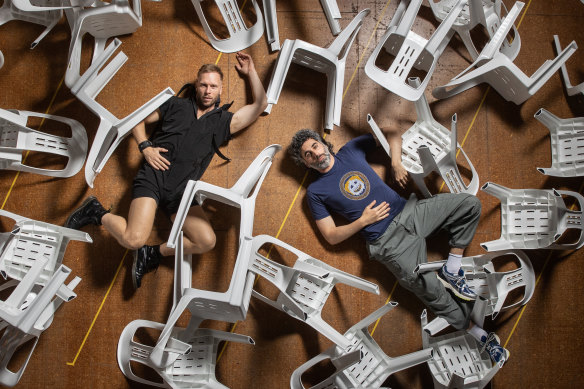
Joe Bray and Peter Paltos both spent time in the Pentecostal church.Credit: Simon Schluter
He had a realisation: you can take the choreographer out of the church, but you can’t take the church out of the choreographer. “It makes sense in hindsight. For the most formative 18 years of my life I had moved in this certain way and hadn’t clocked that it’s in every show I do.”
For those who know his previous work, which includes Daddy, I Liked it, BUT and Biladurang (memorably staged in a hotel room), it’s not such a revelation. Perhaps more than any of his contemporaries, Bray’s practice is known for producing a sense of communal experience among strangers. They’re rituals that might be described as participatory or immersive, but unlike most forms of audience interaction they’re the kinds of ceremonies that invoke a sense of connection and welcome rather than deer-in-the-headlights terror.
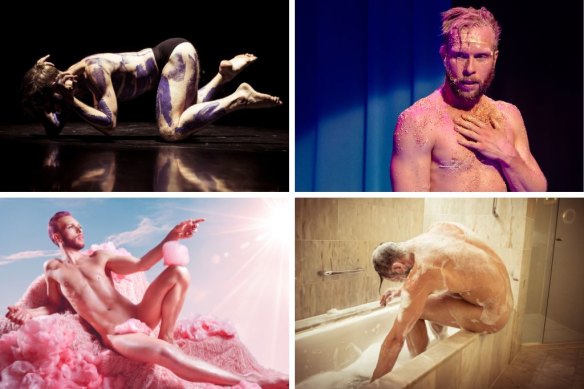
Joel Bray in, clockwise from top left, Chunky Move’s Dharawungara, Daddy (also bottom left) and Biladurang.
What is a surprise, however, is how Bray’s ability to weave beguiling theatre was this close to being used for very different ends. Not long before he left the church, he’d been planning to become a Pentecostal pastor himself. “I was drunk on that power. I was preaching at 16 to a congregation of adults. And then when you’re preaching, everyone’s going ‘amen!’, so maybe that’s why I make participatory work, because I need my audience to be constantly responding.”
He’d even decided to study public relations and organisational psychology at uni, so he could master new strategies to evangelise. “I wanted to become one of those really famous, really rich evangelists.”
Luckily a trip to Sydney swayed him from the path. It might be where the mothership of Hillsong first landed, but it was also where he was introduced to a whole new world of queer culture. “I remember going: ‘Oooh. Actually, I want to do this.’ Thank God.”
God’s loss is our gain. Homo Pentecostus promises to be as rich and nuanced as Bray’s earlier offerings. Both Bray and Paltos are survivors of genocide – Bray’s Indigenous forebears suffered at the hands of colonising Christians, while Paltos’ Armenian family were persecuted for being in a Christian minority. The fact that they’ve arrived at very different stances towards spirituality is testament to the complexities that are a part of any religion.
Blame it on the Bible, perhaps. “You can make that book say whatever you want. It contradicts itself constantly and is so dense,” says Bray.
“It needs some radical dramaturgy,” adds Paltos.
Bray laughs: “It totally needs a really good edit.”
Homo Pentecostus is at the Malthouse Theatre from May 10.